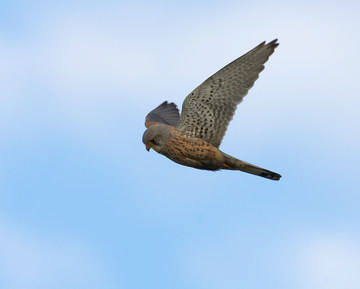
Kestrel © Richard Steel
The winter distribution map is similar to that for the breeding season, with a few records in areas where they were not found to breed, and a few gaps where the species was unluckily missed in winter. Kestrels exhibit a variety of strategies for coping with winter. Some pairs remain together on their breeding territory; others split up, with the male staying and the female moving off to defend a separate winter territory, probably re-forming the pair-bond in spring; some first-year birds squeeze into areas between occupied territories; and others migrate long distances, including Scandinavian birds coming to Britain, some of them making it to the west coast and Ireland. British birds breeding in the lowlands are mostly sedentary while those in the uplands tend to move south, and to lower altitudes (Brown & Grice 2005). Birds fledging late in the season are much more likely to travel far from the nest (Migration Atlas). This mixture of approaches means that Kestrels can probably be found in winter anywhere with sufficient food, and that certainly applies in Cheshire and Wirral. Although inhospitable uplands are deserted for the winter (Winter Atlas), the easy of Cheshire obviously offered enough food and shelter during this Atlas survey for Kestrels to be found in almost every tetrad.
The winter habitat codes show that significant shifts from the breeding season. Farmland comprises an even higher proportion (72% of records), with only half as many in woodland than during the breeding season (7%), fewer in human sites (8%), 5% scrub and a doubling to 6% of the fraction of semi-natural grassland and marsh.
The ‘home range’, the area over which an individual hunts, is at its minimum size in autumn, when first-year birds are finding space for themselves; this is probably tolerable because autumn is the time of maximum vole numbers. In grassland areas, Kestrels in autumn use about 1-2 km2 each but this virtually doubles by late winter as some birds die and others move out (Village 1990).
Whilst Kestrels are most often noticed when hovering, especially over roadside verges, they only do so within a certain range of wind speeds; it is too difficult, or energetically costly, in calm conditions or when the wind is very strong. Birds then usually resort to sitting on perches, especially telegraph poles and the like, dropping on to prey. Kestrels seem to avoid hunting in rain if possible, and may spend hours sitting in a sheltered site.
It can be difficult to tell on what they are feeding, and no observer for this atlas commented on prey in winter. Small mammals seem to be the staple if they can be found: Kestrels can detect vole urine, visible in ultraviolet light, and probably use this faculty to select areas with high concentrations of the mammals. Bank Voles, Wood Mice and Harvest Mice are less strictly nocturnal during winter, and thus more likely to be available to Kestrels. Fewer birds are taken in winter in upland areas, reflecting the scarcity of small- to medium-sized avian prey there, but on farmed land with flocks of seed-eaters, birds may form the majority of Kestrels’ winter food (Shrubb 1993). Some Kestrels attack passerine roosts.
Apart from a respite from persecution, there has probably been little change in the Kestrel’s status for a century or more. Alfred Newton’s Dictionary of Birds (1893 - 1896) described the Kestrel as ‘almost entirely a summer migrant’, but Coward and Oldham (1910) helpfully comment that ‘in Cheshire the bird is as frequently met with in winter as in summer’, a phrase that holds good today. There is a hint that the species has changed its habits, however, with Coward and Oldham deeming worthy of special comment the fact that Brockholes (1874) stated that they ‘sometimes breed in a hollow tree’.
Sponsored by S. C. Nichols

